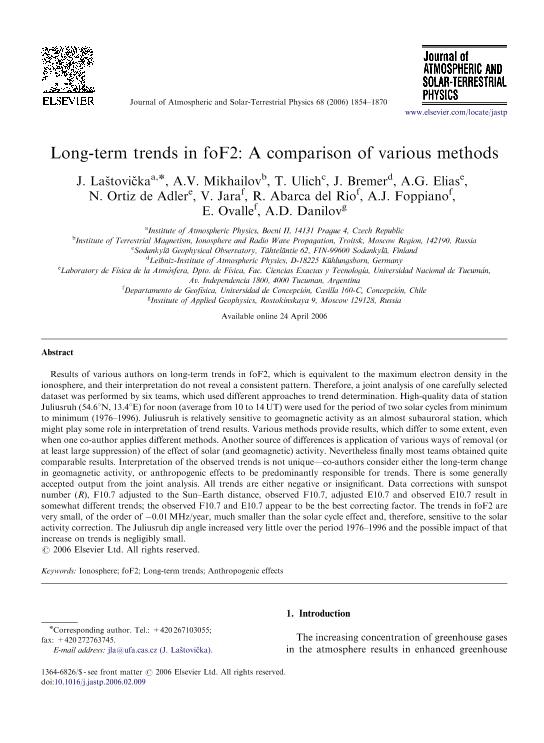Mostrar el registro sencillo del ítem
dc.contributor.author
Lastovicka, Jan
dc.contributor.author
Mikhailov, Andrei V.
dc.contributor.author
Ulich, Thomas
dc.contributor.author
Bremer, Jurgen
dc.contributor.author
Elias, Ana Georgina

dc.contributor.author
Ortiz de Adler, Nieves del Carmen

dc.contributor.author
Jara, V.
dc.contributor.author
Abarca del Rio, Rodrigo
dc.contributor.author
Foppiano, Alberto J.
dc.contributor.author
Ovalle, Elias
dc.contributor.author
Danilov, Andrei D.
dc.date.available
2019-09-19T19:07:27Z
dc.date.issued
2006-12
dc.identifier.citation
Lastovicka, Jan; Mikhailov, Andrei V.; Ulich, Thomas; Bremer, Jurgen; Elias, Ana Georgina; et al.; Long-term trends in foF2: A comparison of various methods; Elsevier; Journal of Atmospheric and Solar-Terrestrial Physics; 68; 17; 12-2006; 1854-1870
dc.identifier.issn
1364-6826
dc.identifier.uri
http://hdl.handle.net/11336/83912
dc.description.abstract
Results of various authors on long-term trends in foF2, which is equivalent to the maximum electron density in the ionosphere, and their interpretation do not reveal a consistent pattern. Therefore, a joint analysis of one carefully selected dataset was performed by six teams, which used different approaches to trend determination. High-quality data of station Juliusruh (54.6ºN, 13.4ºE) for noon (average from 10 to 14 UT) were used for the period of two solar cycles from minimum to minimum (1976 ?1996). Juliusruh is relatively sensitive to geomagnetic activity as an almost subauroral station,which might play some role in interpretation of trend results.Various methods provide results,which differ to some extent, even when one co-author applies different methods.Another source of differences is application of various ways of removal (or at least large suppression) of the effect of solar (and geomagnetic)activity.Nevertheless .nally most teams obtained quite comparable results. Interpretation of the observed trends is not unique -co-authors consider either the long-term change in geomagnetic activity, or anthropogenic effects to be predominantly responsible for trends. There is some generally accepted output from the joint analysis.All trends are either negative or insignificant. Data corrections with sunspot number (R, F10.7 adjusted to the Sun -Earth distance, observed F10.7, adjusted E10.7 and observed E10.7 result in somewhat different trends; the observed F10.7 and E10.7 appear to be the best correcting factor. The trends in foF2 are very small, of the order of 0.01 MHz/year, much smaller than the solar cycle effect and, therefore, sensitive to the solar activity correction. The Juliusruh dip angle increased very little over the period 1976 -1996 and the possible impact of that increase on trends is negligibly small.
dc.format
application/pdf
dc.language.iso
eng
dc.publisher
Elsevier

dc.rights
info:eu-repo/semantics/openAccess
dc.rights.uri
https://creativecommons.org/licenses/by-nc-sa/2.5/ar/
dc.subject
Long-Term Variation
dc.subject
Ionosphere
dc.subject
F2 Layer
dc.subject
Greenhouse Effect
dc.subject.classification
Meteorología y Ciencias Atmosféricas

dc.subject.classification
Ciencias de la Tierra y relacionadas con el Medio Ambiente

dc.subject.classification
CIENCIAS NATURALES Y EXACTAS

dc.title
Long-term trends in foF2: A comparison of various methods
dc.type
info:eu-repo/semantics/article
dc.type
info:ar-repo/semantics/artículo
dc.type
info:eu-repo/semantics/publishedVersion
dc.date.updated
2019-09-13T14:52:03Z
dc.journal.volume
68
dc.journal.number
17
dc.journal.pagination
1854-1870
dc.journal.pais
Reino Unido

dc.journal.ciudad
Oxford
dc.description.fil
Fil: Lastovicka, Jan. Institute Of Atmospheric Physics; República Checa
dc.description.fil
Fil: Mikhailov, Andrei V.. Institute Of Terrestrial Magnetism; Rusia
dc.description.fil
Fil: Ulich, Thomas. Sodankyla Geophysical Observatory; Finlandia
dc.description.fil
Fil: Bremer, Jurgen. Leibniz-institute Of Atmospheric Physics; Alemania
dc.description.fil
Fil: Elias, Ana Georgina. Universidad Nacional de Tucumán. Facultad de Ciencias Exactas y Tecnología; Argentina. Consejo Nacional de Investigaciones Científicas y Técnicas. Centro Científico Tecnológico Conicet - Tucumán; Argentina
dc.description.fil
Fil: Ortiz de Adler, Nieves del Carmen. Universidad Nacional de Tucumán. Facultad de Ciencias Exactas y Tecnología; Argentina
dc.description.fil
Fil: Jara, V.. Universidad de Concepcion; Chile
dc.description.fil
Fil: Abarca del Rio, Rodrigo. Universidad de Concepcion; Chile
dc.description.fil
Fil: Foppiano, Alberto J.. Universidad de Concepcion; Chile
dc.description.fil
Fil: Ovalle, Elias. Universidad de Concepcion; Chile
dc.description.fil
Fil: Danilov, Andrei D.. Institute Of Applied Geophysics; Rusia
dc.journal.title
Journal of Atmospheric and Solar-Terrestrial Physics

dc.relation.alternativeid
info:eu-repo/semantics/altIdentifier/doi/https://dx.doi.org/10.1016/j.jastp.2006.02.009
dc.relation.alternativeid
info:eu-repo/semantics/altIdentifier/url/https://www.sciencedirect.com/science/article/pii/S1364682606000617?via%3Dihub
Archivos asociados
